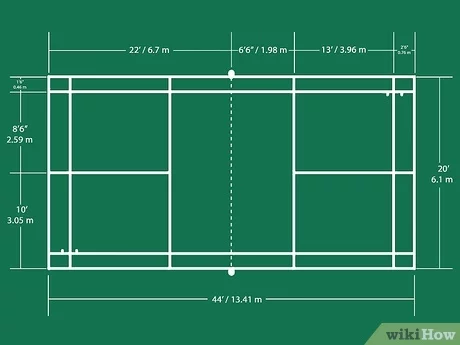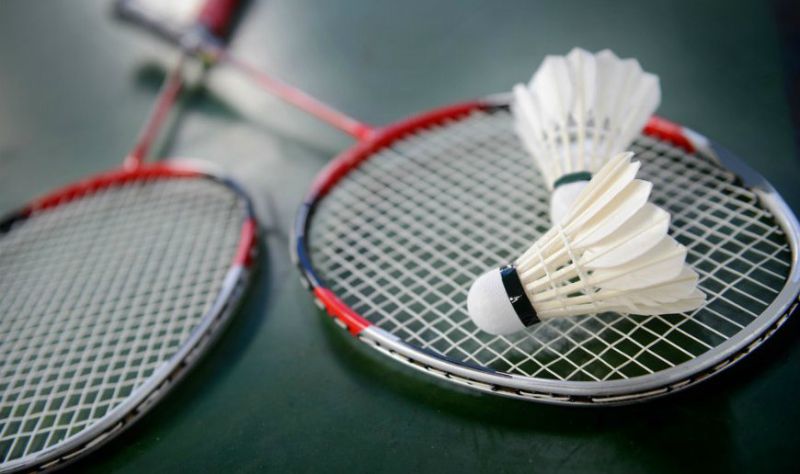Badminton is a popular racket sport played by millions of people worldwide. Whether you’re a beginner or have some experience, understanding the essential rules and scoring of badminton is crucial to enjoying the game and playing it competitively. In this article, we will explore the key rules and scoring tips that every beginner should know to get started in the sport. By grasping these fundamentals, you will be well-prepared to participate in matches and improve your skills. So, let’s dive into the world of badminton rules and scoring.
Table of Contents
The Court and Equipment

Before delving into the rules and scoring, let’s familiarize ourselves with the badminton court and equipment. A standard badminton court is rectangular, measuring 13.4 meters long and 6.1 meters wide for singles, or 13.4 meters long and 5.18 meters wide for doubles matches. The net runs through the center of the court, dividing it into two equal halves. Each player or team uses a lightweight racket to hit a shuttlecock, also known as a birdie or shuttle, over the net. The shuttlecock is made up of feathers or synthetic materials attached to a small, conical base. Now that we understand the court and equipment, let’s explore the badminton rules and scoring.
Serving Rules
Serving is the starting point of every badminton rally, and it follows specific rules. The server must stand within the service court diagonally opposite to the receiver. The serve should always be hit below the server’s waist level, and the racket head must be pointing downwards at the moment of contact with the shuttlecock. The serve must pass over the net and land within the diagonal service court on the receiver’s side. If the server fails to execute a proper serve, it results in a fault. Faults can occur due to various reasons, such as hitting the shuttlecock into the net, hitting it outside the boundaries, or serving illegally. Now, let’s move on to the badminton rules and scoring.
Scoring System

Understanding the scoring system is essential to keep track of points during a badminton match. The game consists of sets, and each set comprises 21 points. To win a set, a player or team must score 21 points and have a two-point advantage over their opponent(s). If the score reaches 20-20, the set enters a “deuce” phase, where the first player or team to gain a two-point lead wins the set. A match can be best of three sets (often in local or amateur matches) or best of five sets (in professional matches). The winner of the match is determined by the number of sets won. Now that we know the scoring system, let’s discuss some badminton rules and scoring.
Scoring Tips for Beginners
- Focus on Accuracy: Instead of trying to hit powerful shots, focus on hitting the shuttlecock accurately over the net and into your opponent’s court. Precision is more important than power, especially for badminton rules and scoring.
- Master the Serve: Practice different types of serves, such as low serves, high serves, and flick serves, to keep your opponents guessing and gain an advantage from the start of each rally.
- Watch Your Footwork: Good footwork is crucial in badminton. Move quickly and efficiently around the court to reach the shuttlecock in time and maintain balance while executing shots.
- Learn Basic Shots: Master fundamental shots like the clear, drop shot, smash, and net shot. Understanding when to use each shot will give you an edge in different game situations.
- Anticipate and React: Observe your opponent’s movements and anticipate their shots. React swiftly to return the shuttlecock and disrupt their strategy.
- Stay Calm and Focused: Badminton can be fast-paced and competitive. Stay calm, focused, and composed during matches to make better decisions and maintain consistency.
Familiarizing yourself
By familiarizing yourself with the essential badminton rules and scoring, you have taken the first step toward becoming a skilled player. Remember to practice regularly, focus on improving your technique, and apply the scoring tips mentioned above. Badminton is not only a physically demanding sport but also a mentally challenging one. With time and dedication, you will develop your skills, strategic thinking, and agility on the court. Enjoy the game, embrace the challenge, and have fun while playing badminton rules and scoring!
Doubles Rules and Strategies

In doubles badminton, teams consist of two players on each side. The rules for doubles are slightly different from singles. Firstly, the serving rotation is different, where the server serves diagonally across the court, alternating between the two opponents. Secondly, communication and coordination between partners are crucial to cover the court effectively and maximize your chances of winning. Strategize with your partner to create opportunities for attacking shots and to defend against your opponent’s attacks. Maintain a balanced court position and be ready to switch sides quickly during rallies. Clear communication and understanding of each other’s strengths and weaknesses will lead to a more cohesive and successful doubles partnership.badminton rules and scoring.
Faults and Penalties
To ensure fair play, badminton rules and scoring has specific rules regarding faults and penalties. Some common faults include touching the net with the racket, hitting the shuttlecock outside the boundaries, obstructing your opponent’s shot, or not adhering to the correct serving rules. These faults result in a point being awarded to the opposing player or team. In addition to faults, players can also receive penalties for misconduct, such as verbal abuse or unsportsmanlike behavior. Penalties may include warnings, point deductions, or disqualification from the match. Understanding and abiding by the rules and regulations of badminton is essential to maintain a fair and enjoyable playing environment for all participants.
Basic Etiquette and Sportsmanship

As with any sport, badminton has its own set of etiquette and sportsmanship standards that players should uphold. Respect your opponents by acknowledging good shots, shaking hands before and after the match, and maintaining a positive attitude throughout the game. Avoid distractions and unnecessary delays during play. It is important to remember that badminton is a competitive sport, but it is also an opportunity to build friendships and enjoy the company of fellow players. Upholding good sportsmanship not only enhances your reputation as a player but also contributes to the overall enjoyment of the game for everyone involved.badminton rules and scoring.
Practice and Continuous Improvement
To excel in badminton rules and scoring, practice is key. Regularly participate in training sessions, practice drills, and matches to improve your skills and stamina. Work on your footwork, shot techniques, and strategic thinking. Seek guidance from experienced coaches or join a badminton club to receive professional training. Additionally, watching professional matches and studying the playing styles of top players can provide valuable insights and inspiration for your own game. Remember, improvement takes time and dedication, so be patient with yourself and stay motivated. Celebrate your progress along the way and set realistic goals to challenge yourself and strive for continuous improvement in your badminton rules and scoring.
Conclusion
By understanding the essential badminton rules, scoring system, and implementing effective strategies, beginners can develop a strong foundation in the sport. Alongside the rules, emphasizing good sportsmanship and maintaining a positive attitude will enhance the overall experience of playing badminton. Remember, practice and dedication are key to improving your skills, and don’t forget to enjoy the game and have fun while playing. So, grab your racket, step onto the court, and embrace the exciting world of badminton. Let the shuttlecock soar and the rallies begin as you embark on your journey to becoming a skilled badminton rules and scoring!
Learn about: Get in the game with Nebraska Volleyball: Serving up the ultimate display of teamwork



